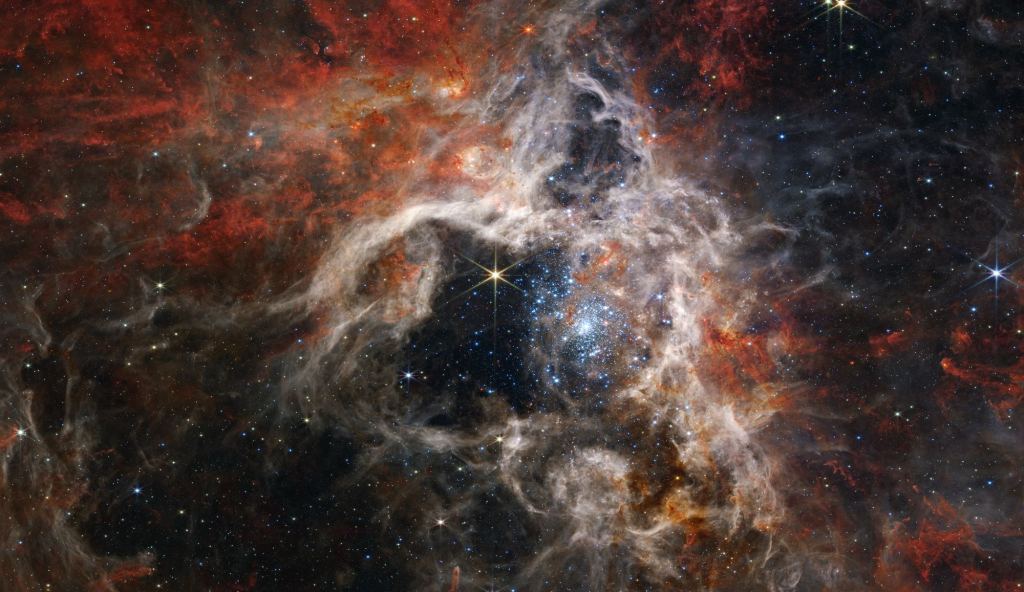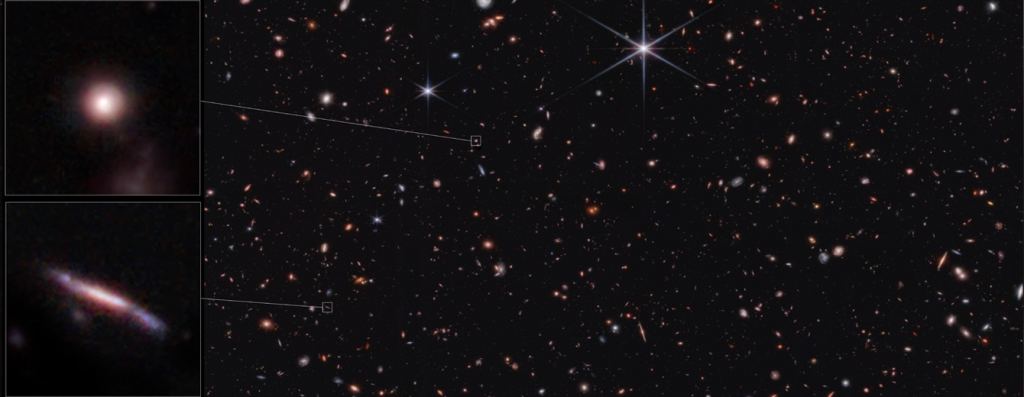The James Webb Space Telescope*, a collaborative effort between NASA, the ESA, and the Canadian Space Agency (CSA), has revealed some stunning new images of the Universe. These images have not only been the clearest and most details views of the cosmos; they've also led to new insight into cosmological phenomena. The latest image, acquired by Webb* 's Mid-InfraRed Instrument (MIRI), is of the star-forming nebula N79, located about 160,000 light-years away in the Large Magellanic Cloud (LMC). The image features a bright young star and the nebula's glowing clouds of dust and gas from which new stars form.
The image above is centered on one of the three giant molecular cloud complexes - dubbed N79 South (S1) - a region dominated by interstellar atomic hydrogen that is ionized. The star is identifiable as the brightest spot in the image, surrounded by six large spokes of light that cross the image. The processed image uses many different colors to indicate different infrared wavelengths, with near-infrared light (7.7-10 microns) shown in blue, while mid-infrared wavelengths (10, 15, and 21 microns) are shown in cyan, yellow, and red (respectively).
This N79 nebula spans over 500 parsecs (1,630 light-years) in the largely unexplored southwest region of the LMC and is often regarded as the younger sibling to the Tarantula Nebula (aka. 30 Doradus). This nebula was imaged recently by Webb (see above), where combined light from varying wavelengths created a detailed image revealing many interesting features (like star-forming regions astronomers were not expecting to find). However, research suggests that for the past 500,000 years, N79 has had star formation efficiency more than twice that of the Tarantula Nebula.
Several other bright objects can be seen in the cloud, which are stars in the early stages of formation (aka. protostars) shown in great detail as layers of colorful wisps. Thanks to Webb 's ability to capture longer and shorter wavelengths of infrared light, these latest image provides insight into the nebula's star forming regions. Since shorter wavelengths are absorbed or scattered by dust grains, mid-infrared light reveals what is happening deeper inside the clouds (which include some young protostars). The image shows a distinct "starburst" pattern surrounding a bright object.
This is known as a "diffraction spike," an artifact only visible around very bright and compact objects that arises from the design of a telescope's mirrors. In this case, the six diffraction spikes extending from the center are due to the hexagonal symmetry of Webb's eighteen primary mirror segments. Astronomers are particularly interested in star-forming regions because their chemical composition resembles that of nebulas observed when the Universe was only a few billion years old.
Unlike nebulae in the Milky Way today, star formation was at its peak during this time, producing particularly massive stars with low concentrations of metal and short-lived by current standards. By taking details images from N79 and similar nebulae, astronomers can compare and contrast star-formation rates to deep observations of distant galaxies in the early Universe.
These latest observations by Webb are part of a program to study the evolution of circumstellar discs and envelopes around stars in formation over a wide range of mass and evolutionary stages. Webb 's sensitivity will allow astronomers for the first time, to detect these planet-forming disks around stars of similar mass to that of our Sun and at distances comparable to that of the LMC (around 160,000 light-years). This will shed light on how planetary systems like our own formed and evolved, potentially providing clues as to where life may have also emerged in our galaxy.
*Further Reading: ESA*
 Universe Today
Universe Today


